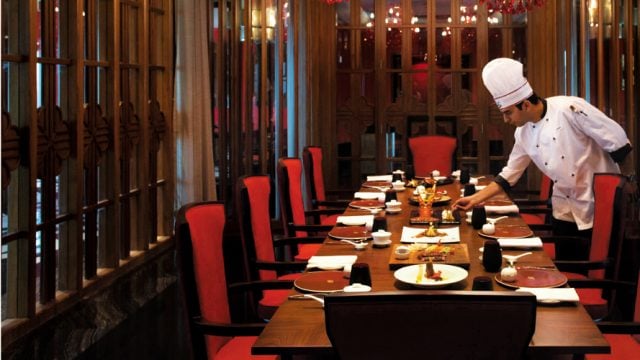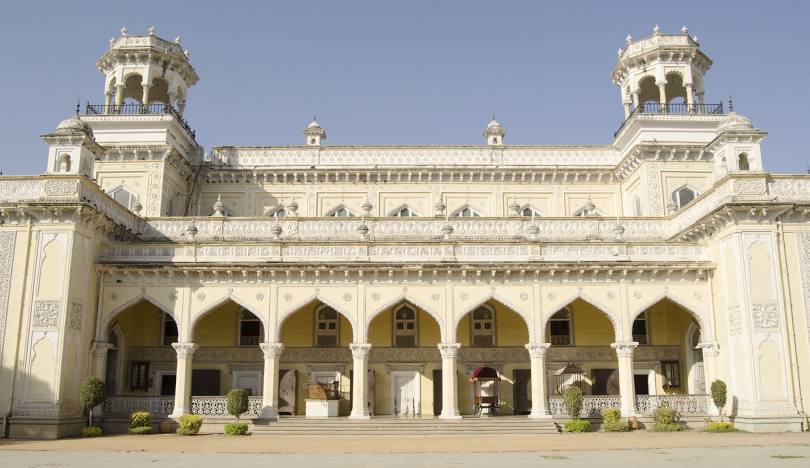First, you’re on a bland highway going into town. Then you hit Engine
There was, of course, nothing secret about Falaknuma Palace when Vikar-ul-Omra set about building his personal “mirror to the sky” in 1884. Hyderabad was a different place then and the old city was, well, the city. A few years after its completion in 1893, the palace was gifted by the Paigah Prime Minister to Mahbub Ali Khan, the sixth Nizam, who liked it so much he actually deigned to use it as a guesthouse and as a fifth home. His son and heir, Osman Ali Khan, the infamous seventh Nizam, didn’t care for it and what with the Golconda mines practically spouting jewels — not to mention the hundreds of concubines and children who competed for his attention — Falak-numa fell by the wayside. In 1967, on his death, ownership of the palace (and most everything else the last Nizam owned) transferred to his grandson, the hapless Mukarram Jah. This man’s life was a train wreck of rapidly escalating proportions until some point in the 1990s, when Esra Birgin — his first wife — somehow convinced him to let her salvage his disintegrating empire, and that is when the Taj came into the picture.
In one way or another, the Taj Falak-numa Palace is an endeavour that lasted fifteen years. It shouldn’t take that long to turn a disused palace into a deluxe getaway but then Falaknuma is no ordinary palace. For one thing, it was caught in the legal and financial quagmire that Mukarram Jah had allowed himself to sink into; for another, the entire restoration was supervised by a woman who wouldn’t let a door knob through without her approval. Esra Birgin was apparently responsible for a healthy turnover of architects, restorers and designers in the process of making this hotel; now that it’s all over, the people involved speak of her with a sadomasochistic wistfulness.
The good news is that what doesn’t kill you only makes you stronger — or, in the case of the Taj Falaknuma Palace, miraculously restrained. The location of the palace, high up on the hill, is perfect: all of Hyderabad sprawls like a carpet below. A significant portion of the restoration was horticultural and this is a success, the result being something that is neither unnaturally lush nor unmindful of the rocks. Up there, the air is perfect and, recognising this, a lot of the hotel is outdoors — there are acres of gardens, split-level lawns, grottos and what have you. At the very edge of the promontory is a spacious, canopied balcony called the Gol Bungalow, a sit-out where you can watch Hyderabad come glitteringly alive at sunset.
Inside the palace, the décor is infallibly right. A hundred and something years is probably just enough time to make Italian marble look passable. Even so, parts of the main entrance and the main staircase look like they were cast in high-grade plastic, not unlike the style of finer addresses in, say, Delhi’s Greater Kailash (the heritage homes of our future). It should be irritating but in fact it’s playful, like the unremarkable European art and portraiture that is splattered across the ceiling and the walls. Smiling cherubs and stern ancestors, like marble, need the gift of time to turn from garish into whimsical. For the most part, however, the interior of the palace is filled with dark wood, thick chairs and dense detail that is so meticulous it could be the set of a Merchant Ivory film. And that’s the thing. There’s no pretence: Falaknuma was never intended to be anything but a collection of the greatest hits of Europe at the turn of the last century and it achieves the effect superbly. This is no mean feat — given the decrepit state of the palace when it was handed over to the Taj, and considering the many misadventures in historical fiction executed across the country by hotel chains (this one included). Falaknuma is a template of how things should be done.
As for me, I got lost in the details. I latched and unlatched the doors in my room repeatedly to check if the fleur-de-lis brass fixtures were original (they were, as with all fixtures within the main palace, though the ones in the courtyard rooms are nice replicas). I enjoyed playing with the fans; cased with crystal in the grand rooms of the main palace, coated with cool cream enamel in my room and recreated in all their art deco simplicity in the courtyard rooms. I spent hours in the library, a disconnected and wildly eclectic collection of some 6,000 books; dull, respectable leather-bound volumes of dull, respectable words, rare Qurans, Persian manuscripts, touchingly inscribed guest registers, a full set of Anatole France and the Agricultural Gazette of New South Wales; which is to say, a library assembled by bulk consignment at a time when books were interior design.
I was particularly fascinated with the bathroom of one of the wives of one of the Nizams (since there were so many in the former category, it’s hard to tell who this was exactly). Her quarters are preserved intact and function as the hotel’s in-house museum. I felt only slightly weird entering her bathroom and turning on the taps in the intricate industrial apparatus that was her bath, or lifting the wooden seat of her commode. (I did, however, resist the temptation to bounce on her four-poster bed.) Wherever she is, and whoever she is, I can’t imagine her being thrilled to know that various French tourists and Indian commoners wandered through her loo last week but I was very excited to be there.
The food was just so — and this is saying a lot. The Taj Falaknuma Palace has two restaurants: Celeste, which serves Mediterranean food and does it well, and Adaa, which is a sort of native surprise. Adaa serves Hyderabadi cuisine but not like anything I’ve tasted before. Firstly, I didn’t know that Kakinada crab cakes even existed, or that they tasted that good. Secondly, I’ve never had majjiga — sour, spiced buttermilk — frozen in flakes and served in a shot glass, and it’s brilliant. Thirdly, I’ve never eaten biryani and mirch ka salan and not felt nauseous; it’s the serving size that did the trick.
And I don’t even like palaces. Rajasthan’s fussy flounces do nothing for me and I consider Mysore royal architecture to be a human rights violation. Naturally, I’ve had to re-evaluate my feelings and I think I’ve arrived at an honourable compromise. I’ve decided I like palaces if they’re English in style and Saracenic at heart. Or subtle and peaceful with good classical music on low volume. Or if they’re designed by imperious Turkish women and run with straightforward local kindness. Or if they’re owned by diabetics. Or old men who are bonkers and broke. Or something.
The information
Location Engine Bowli, Falaknuma, Hyderabad
Contact 040-66298585, www.tajhotels.com
Nizams of Hyderabad
Taj Falaknuma Palace
Leave a Reply
You must be logged in to post a comment.





